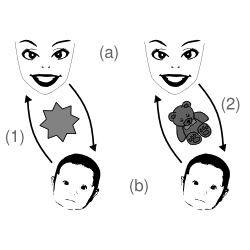慰藉物
外觀
慰藉物(英:Comfort object)或過渡物,是一種物件,用來提供心理上的慰藉,尤其是在不同尋常的環境裏。兒童在就寢時也常需要它們。對孩童來說,慰藉物可能是一塊毛巾(日語:安心毛布),一個填充玩具,等等。[1]
兒童心理發展
[編輯]
在兒童教育領域,常使用被稱作「過渡性客體」[2](也稱「過渡性物體」[3])的事物,常見的如洋娃娃、泰迪熊、毛毯等,這通常可以在一定程度上從心理層面代替母親與孩子的關係。
成人後使用
[編輯]成人也可能使用慰藉物。在一項2008年的研究中,研究者們發現索尼公司的AIBO機器寵物可以減少養老院裏老人們的孤獨感。[4]
日本的成人有時用慰藉物來應對現代生活中的壓力。[5]
用於心理治療
[編輯]在西方,有時填充玩具會被裝備在消防車或警車上,這樣可以為經歷事故乃至創傷性休克的受害者提供慰藉。
心理學家正在進行用厚毛毯代替緊身衣的實驗。他們發現,有些罹患自閉症的兒童,在接觸到慰藉物後,會變得更加平靜,不那麼激動。[7]
流行文化
[編輯]在查爾斯·舒茲所著的《花生漫畫》系列漫畫中,安全毯一詞被使用並流行開來。奈勒斯·潘貝魯特把一張毯子叫做「安全與幸福之毯」[8][8]
慰藉物的概念在電視連續劇《老友記》中也被提到。"The One with the Pediatrician"一集中,羅斯提醒錢德勒,他帶了一張安全毯到大學裏。
參見
[編輯]參考資料
[編輯]- ^ Iannelli, M.D., Dr. Vincent. Security and Comfort Objects. About.com. Dec 12, 2004 [2009-07-17]. (原始內容存檔於2013-01-15).
- ^ 《心理與健康》. 且游且渡—沙盘游戏中的过渡性客体. 中國數字科技館. [2022-09-07]. (原始內容存檔於2022-09-07).
- ^ 作者:Endevelt-Shapira 來源:《科學進展》. 婴儿闻到母亲气味时会与陌生人关系更好. 科學網·論文. 2021-12-14 [2022-09-07]. (原始內容存檔於2022-09-07).
- ^ Study: Dogs, Robots Cheer Elderly. Fox News. March 3, 2008 [2009-07-17]. (原始內容存檔於2009-03-26).
- ^ Security Blankets for Adults[失效連結] Kathi's Mental Health Review, March 25 2002
- ^ 存档副本. [2011-08-08]. (原始內容存檔於2011-08-13).
- ^ 存档副本. [2014-10-02]. (原始內容存檔於2014-10-06).
- ^ 8.0 8.1 存档副本. [2012-07-02]. (原始內容存檔於2021-02-25).
擴展閱讀
[編輯]- Abram, J. (1996). The Language of Winnicott. A Dictionary of Winnicott’s Use of Words, Karnac Books, London
- Dell』Orto, S. (2003). W.D. Winnicott and the transitional object in infancy. Pediatric Medicine Chirurgic 25(2), 106-112.
- Mitchell, S. A., Black, M. J. (1995). Freud and beyond: A history of modern psychoanalytic thought. New York: Basic Books.
- Passman, R. H. (1977). Providing attachment objects to facilitate learning and reduce distress: The effects of mothers and security blankets. Developmental Psychology, 13, 25-28.
- Passman, R. H. (1987). Attachments to inanimate objects: Are children who have security blankets insecure? Journal of Consulting and Clinical Psychology, 55, 825-830.
- Passman, R. H., & Halonen, J. S. (1979). A developmental survey of young children's attachments to inanimate objects. Journal of Genetic Psychology, 134, 165-178.
- Passman, R. H., & Lautmann, L. A. (1982). Fathers', mothers', and security objects' effects on the responsiveness of young children during projective testing. Journal of Consulting and Clinical Psychology, 50, 310-312.
- Winnicott, D.W. (1971). Playing and Reality, Routledge, London
- Young, R. M. (1989). 'Transitional phenomena: production and consumption', in B. Richards, ed., Crises of the Self: Further Essays on Psychoanalysis and Politics. London: Free Association Books, pp. 57-72.
- Young, R. M. (1994). Mental Space. London: Process Press.
- Creature Comforts, People and Their Security Objects by Barbara Collopy O'Halloran and Photographed by Betty Udesen.
